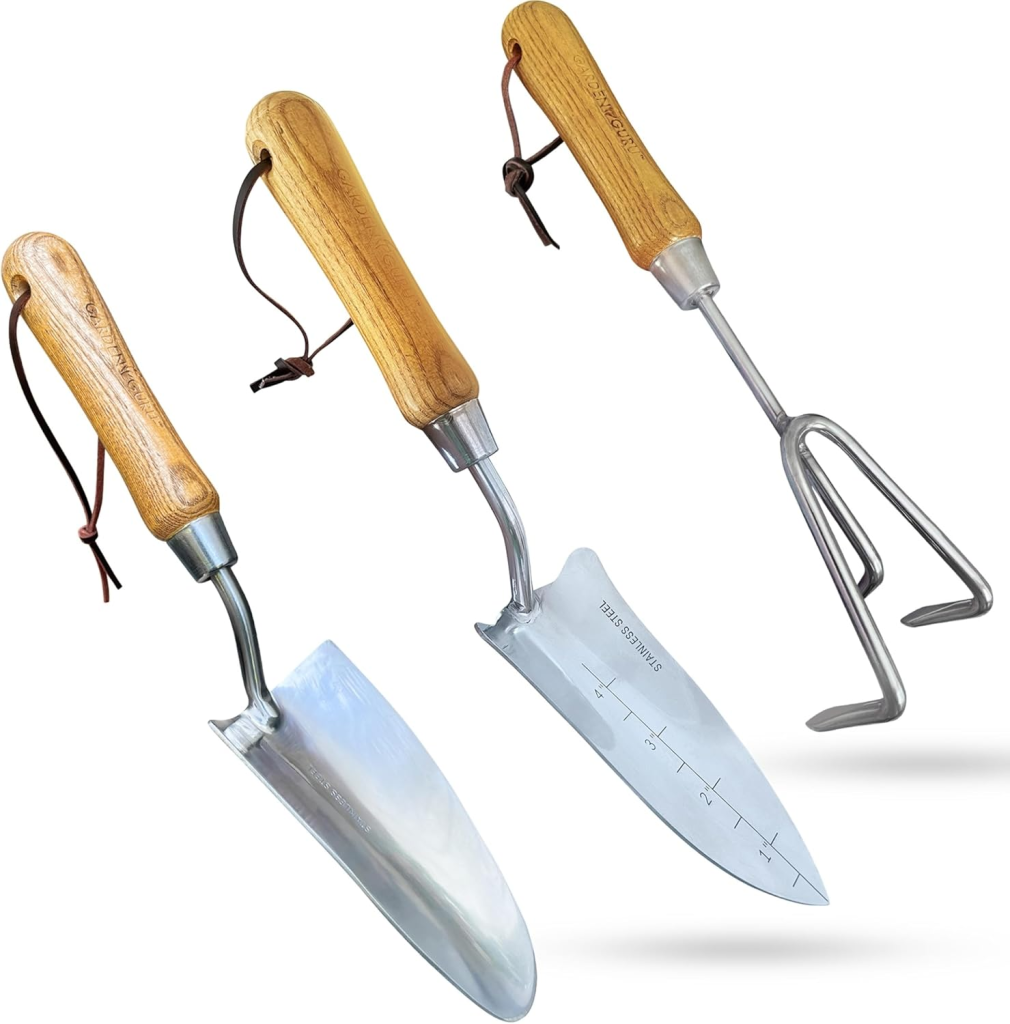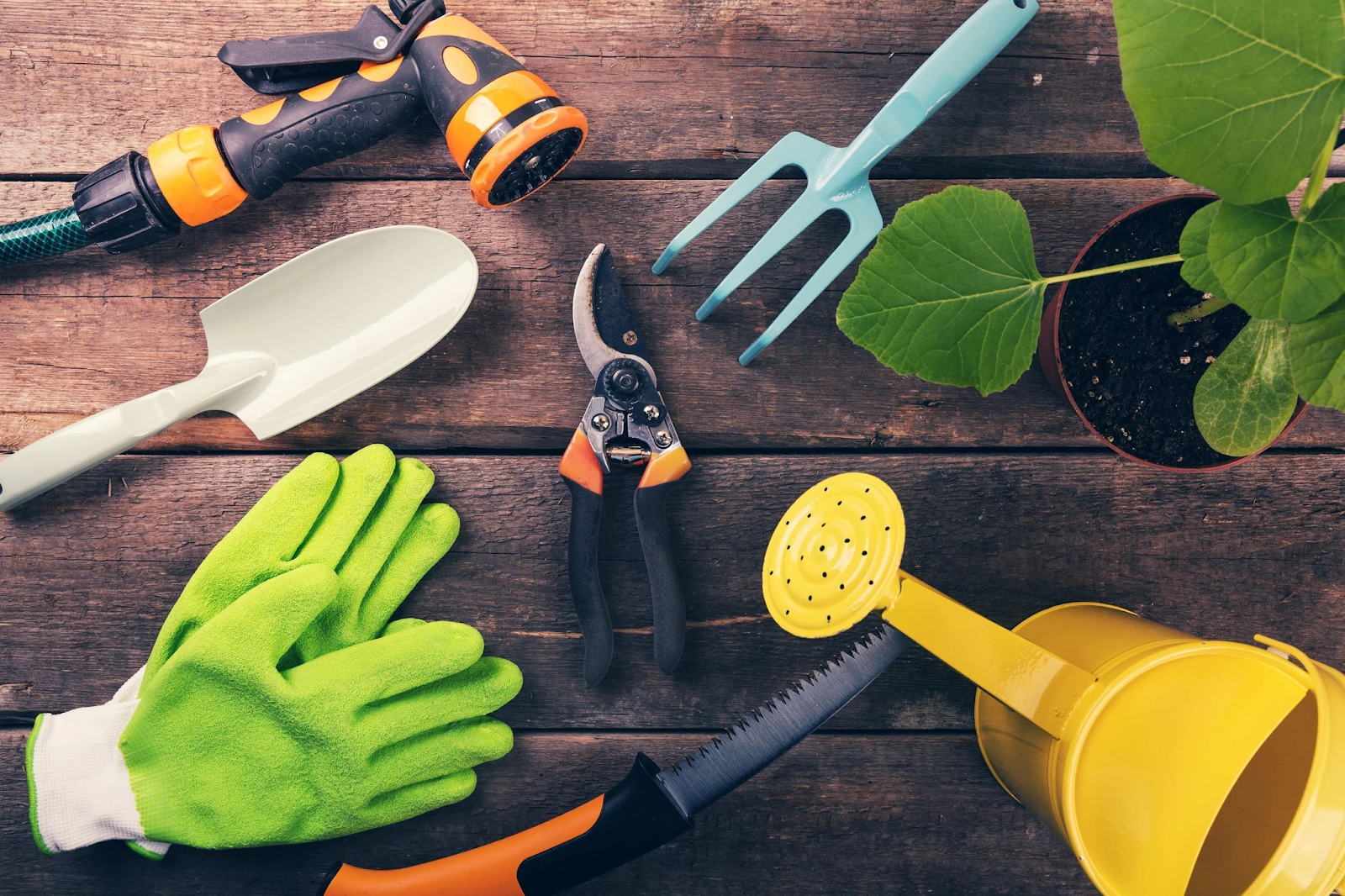Stocking the shed with beginner gardening tools like an ergonomic hand trowel, sharp bypass pruners, and breathable gloves keeps early setbacks at bay. While stainless-steel blades and molded grips, praised for cutting wrist strain and resisting rust, prove their worth long after seed packets are empty.
Layer in a digging spade, lightweight hose, and a watering can with a removable rose (sprinkle head), and the core lineup of essential garden equipment is ready for every transplant, trim, and tidy-up.
Choosing quality now means fewer replacements, healthier roots, and smoother weekends; exactly why curating the right gardening tools for success sets the stage for seasons of flourishing beds, not frustration.
Why the Right Tools Make Gardening Easier
Swap a dull shovel for a balanced, ergonomic model and the job finishes sooner with fewer sore joints. Angled grips and lightweight alloys cut wrist strain and back flexion, so bigger beds get turned without mid-day pain.
Clean, sharp blades also slice roots cleanly, limiting infection pathways and boosting plant survival. Those concrete gains stack up as benefits of gardening tools built for function, not flair.
Faster digging, precise pruning, and longer tool life translate directly into gardening efficiency. By pairing each task with its ideal helper, every lift, cut, and scoop feels smoother, turning weekend chores into gardening made easy, season after season.
Hand Tools Every Beginner Gardener Should Own
Fresh seedlings thrive when essential hand gardening tools are in the tote from day one. A rust-resistant stainless-steel trowel etched with inch marks sinks transplants to perfect depth and shrugs off wet soil for years.

FOUND ON AMAZON
A forged four-tine garden fork breaks up compacted beds 12 inches deep, boosting drainage without power tillers. Bypass pruning shears featuring shock-absorbing cushions and replaceable blades spare wrists while leaving stems with clean, disease-free cuts. Add a fulcrum-style weeder; its L-shaped notch levers dandelions out whole, protecting nearby roots.
Together, these four tools cover garden hand tool basics. During selecting garden hand tools, check steel grade, handle grip, and warranty length; quick checkpoints that keep the budget intact and beds thriving.
Power Tools to Simplify Beginner Gardening Tasks
Electric tillers and compact cultivators cut soil prep from hours to minutes. The BILT HARD Electric Tiller Cultivator turns a 14-inch strip of hard ground into seed-ready fluff in one pass, yet weighs under 18 lbs. and starts with a single button, a textbook easy-to-use garden power tools.

FOUND ON AMAZON
For trimming chores, the Stihl HSA 26 cordless hedge trimmer runs up to 120 minutes and tips the scale at just 2 kg, a BBC Gardeners’ World “ease-of-use” pick; proof that beginner-friendly gardening machines aren’t bulky or loud.
Author’s Notes: Check out our post on The Best Tools for Pruning and Trimming Plants for an in-depth guide to choosing the right pruning and trimming tools!
Pair either tool with a lightweight lithium pack and see garden tasks simplified: faster soil turnover, sharp hedge lines, and far less next-day soreness. Stick to battery models under 35 lbs, push-button starts, and keep a spare charged so weekend projects never stall.
Essential Watering Tools for a Thriving Garden
A lush garden starts with dependable water gear. Garden watering essentials begin with a kink‑resistant rubber or hybrid hose that stays flexible and leak‑free, even in scorching sunshine.
Pair that with a metal‑spout watering can; plastic cans shrug off rust and suit quick top‑ups, while metal models last for years if drained before frost hits.

Next, level up from beginner garden irrigation to compact drip kits snap along beds and pots, deliver moisture straight to roots, and cut water use compared with overhead sprinkling. Finish the lineup with a shut‑off nozzle or timer so flow stops and the instant soil looks glossy.
Smart Storage Solutions for Your Gardening Tools
Nothing slows weekend planting like hunting for a missing trowel. Start with a weather-proof shed or slim deck box; the raised floor and vents fend off rust while keeping shovels and rakes upright. Prime gardening tool storage does not mean you need a huge shed or a garage but come in compact sizes that meet all space constraints.

FOUND ON AMAZON
For quick-grab items, repurpose a five-gallon bucket: fill it with sand mixed with a few drops of mineral oil to clean and oil blades every time they’re parked. Finish with clear-label bins for seeds and gloves, then group long-handled tools on a rolling rack. These bite-size tool organization tips turn cluttered corners into smart, breezy garden storage ideas ready for next season.
Author’s Notes: Check out our post on Creative Garden Tool Storage Ideas for more ways to store gardening tools!
Tool Maintenance Tips to Extend Their Lifespan
Clean blades slice through stems like butter, but only if they’re rust-free and sharp. Gardening tool maintenance starts with knocking off soil the moment work wraps up; a stiff brush and a quick rinse stop grit from grinding edges.
Dry metal fast, then swipe a rag dipped in light oil to block rust and keep hinges gliding. A sharpening file or block set restores a keen edge on pruners and shovels; a few strokes after every couple of sessions beats back crushing cuts. And handles stay splinter-free when rubbed with boiled linseed oil each season.

For storage, hang tools in a dry shed or plunge heads into an oiled sand bucket, as mentioned prior, this step is stressed because it cleans, lubes, and guards against rust in one move. Follow these tool care basics and you’re quietly prolonging tool lifespan year after year.
Budget-Friendly Ways to Assemble Your Gardening Toolkit
Starting a garden doesn’t require a shiny aisle of tools from the hardware store; cherry-picking bargains can load your shed for less than a take-out dinner. Big-box retailers clear out stock every late summer, making this the perfect time to get affordable gardening tools.
Next stop: yard sales and thrift shops. They are a great place for very good deals. Facebook Marketplace and local buy-nothing groups list everything from gently used hoses, spades, to kneeling pads and bigger ticket items, letting anyone practice gardening on a budget without sacrificing quality.

Also, watch end-of-season closeouts online. Combine these channels and a sturdy second-hand hand fork joins gloves and a pruning saw, rounding out a lean budget gardening toolkit that’s ready for planting day.
Safety Tips for Using Your Gardening Tools
Loppers, trowels, and hedge shears are harmless until they aren’t, so treat every blade like it’s sharp enough to warrant respect.
Nail gardening tool safety by slipping on tough gloves, close-toed shoes, and protective eyewear before the first cut.

Safe gardening practices begin with matching each tool to its designed task, keeping blades sharp but sheathed, and unplugging or locking power tools whenever you step away.
Clean and disinfect metal surfaces after use to stop plant diseases hitching a ride. Lift soil bags with bent knees, not a curved back, and keep wrists in a neutral “thumbs-up” line to dodge tendon strain. Storing gear on hooks, not the ground, caps off solid injury prevention and spares toes from surprise encounters.
Choosing Ergonomic Gardening Tools for Comfort

Using ergonomic gardening tools like cushioned handles, lightweight alloys, and shovel shafts set your wrist at natural angles which cuts joint stress and reduces strain on the wrist. Soft, non-slip grips and balanced weight distribution keep palms relaxed and limit slippage during wet spring sessions.
Long-handled trowels and hoes let knees stay off the soil while shoulders stay low, making them truly comfortable garden equipment that works with the body instead of against it.
The payoff is clear: longer weeding or pruning streaks without numb fingers, plus fewer next-day aches; a real win for beginners and older gardeners alike focused on reducing gardening fatigue and sticking with the hobby all season.
Conclusion: Embrace Gardening with Confidence and Ease
Fresh soil under your nails feels less daunting once a sturdy trowel, sharp pruners, and breathable gloves are already waiting in the shed. That basic trio turns planting from guesswork into muscle memory.
Pack them, add a watering wand and a lightweight rake, and watch your gardening confidence bloom. With reliable gear doing the heavy lifting, aching wrists give way to a joyful gardening experience, and every seedling enjoys a truly successful gardening start. Let us know what are your favorite beginner gardening tools and hacks in the comment section below!



1 thought on “Essential Gardening Tools For Beginners Guide”